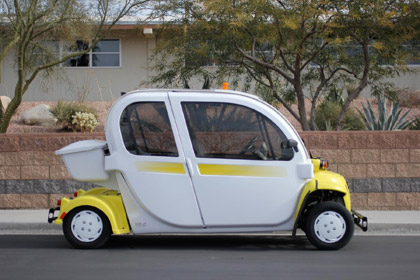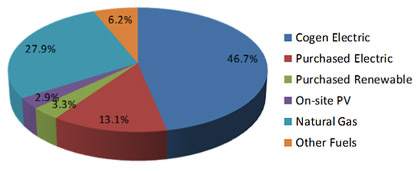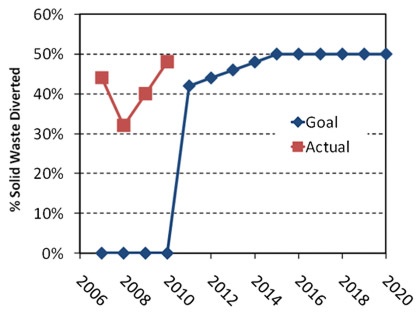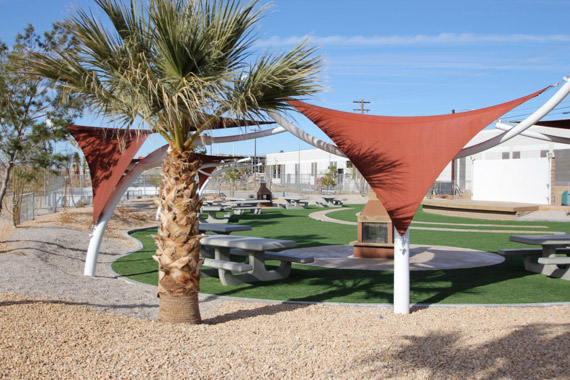USMC’s Twentynine Palms: Mission-Critical Sustainable Practices
Military operations and environmental protection are often thought to be at odds, but such perceptions are not, in fact, reality. That said, two questions frequently come to mind: (1) What could sustainability and conservation have to do with national security, and (2) How could training Marines be anything but contrary to sustainability, ecology and protection of natural resources? Marine Corps Air Ground Combat Center (MCAGCC), also known as the “Combat Center,” has been at the forefront of planning and implementing sustainable approaches across many fronts for the specific purpose of training Marine Air Ground Task Forces in command, control and coordination of kinetic and non-kinetic fires. Remaining at the forefront ensures this training mission can continue into the future unimpeded while staying compliant and preserving the environment for future generations.
The mission of the Marine Air Ground Task Force Training Command (MAGTFTC) at the Combat Center is to conduct relevant live-fire combined arms training, urban operations, joint/coalition level integration training that promotes operational force readiness. It also provides facilities, services and support responsiveness to its resident organizations. In other words, the installation is focused on deploying mission-ready Marines to win traditional wars, to defeat terrorists and to respond to emerging threats to the Nation’s security.
The Combat Center is located in the southern Mojave Desert approximately 50 miles northeast of the City of Palm Springs. It is, by far, the largest live-fire and maneuver training base in the Marine Corps, and it consists mainly of rugged desert terrain, which is perfect for training Marines. The training mission is preserved by maintaining its natural and cultural resources under direction of the Natural Resources and Environmental Affairs (NREA) Division.
To meet current training demands, the Combat Center’s population has grown and now approaches 30,000 military and civilian personnel. The military history of the installation began in 1941 when Condor Field was established by the Army Air Force to train glider pilots. In 1944, the Navy assumed control of the facility and used it for flight training, bombing and strafing. At the end of World War II, the facility was placed in caretaker status. In 1952, the Marine Corps acquired Condor Field and more than 900 square miles near the City of Twentynine Palms for use in training Marines with newly developed long-range weaponry. In its 70 years, the training facility has progressed from an alcove in the desert to a national asset. Past facility expansions and Grow-the-Force initiatives have resulted in a premier desert training installation.
First-of-its-Kind Action Plan
Since the desert environment in its natural state demands careful resource utilization, the development of energy independence capabilities, on-site remediation operations, recycling/reutilization programs and implementation of non-potable/recycled water resources was occurring at the Combat Center long before sustainability was elevated to its current awareness level.

Photo Credit: Twentynine Palms Marine Corps Air Ground Combat Center
|The Combat Center’s not-tactical vehicles consist of compressed natural gas, E-85 powered vehicles, hybrid electric vehicles and electric powered global electric motorcars.
In 2010, NREA spearheaded development and oversight of the Combat Center’s sustainability in a first-of-its-kind Installation Sustainability Action Plan (ISAP), which addressed Executive Orders, specifically 13514 and 13423, and the Department of Defense (DoD) Strategic Sustainability Performance Plan (SSPP).
The plan was a collaborative effort between numerous staff to include public works, logistics and environment. Potential projects and standard operating procedures (SOPs) were developed that would achieve mandated sustainability metrics. The effort was documented in an action-oriented strategy developed to be consistent with sustainability metrics provided in the DoD SSPP. The ISAP is a comprehensive plan addressing energy efficiency, renewable energy, vehicle fleet management, potable and non-potable water conservation, solid waste and hazardous waste management, greenhouse gas (GHG) emissions, high-performance and sustainable buildings, sustainable acquisition, an Environmental Management System and more.
These initiatives at the Combat Center have been recognized with various awards to include the Department of Energy Federal Energy and Water Management Award (2010), Secretary of the Navy (SECNAV) Environmental Awards (2008, 2009), SECNAV Energy Award (2010), SECNAV Sustainability Award (2010), Commander-in-Chief’s Installation Excellence Award (2010, 2011) and Mojave Green Award (2008, 2009 and 2010). For each sustainability metric, background information, metric status and recommendations were researched in-depth. Of the 19 sustainability metrics applicable, eight are being met or are on track to be met, nine have been deemed achievable with action and only two are considered difficult to meet. The latter include greenhouse gas emissions and fossil fuel usage. ISAP provides the Combat Center with an effective, enduring and evolving management tool to roadmap future sustainability efforts.
Alternative Energy & High-Performance Buildings
Energy is a key component of sustainability that supports military readiness. Using a combination of on-site power generation and solar arrays to supply the majority of its power needs, the Combat Center is improving its energy security. A high-efficiency 7.2 MW natural gas cogeneration facility – the largest in the Marine Corps – provides more than 60 percent of the required electricity needs. Further enhancing efficiencies gained, exhaust heat from the cogeneration facility is also used to heat and to cool the buildings aboard the Combat Center. The cogeneration facility and solar arrays supply 95 percent of energy requirements in winter months.
Effective energy management planning saves the Marine Corps and the Combat Center as much as $7M annually in energy costs. In addition, construction of a second 9.2 MW cogeneration facility is currently underway, which will further enhance security and military readiness.

Photo Credit: Twentynine Palms Marine Corps Air Ground Combat Center|FY 2010 MCAGCC Energy Consumption by Source
In 2010, approximately 6.2 percent of electricity was supplied by renewable energy. Aggressive efforts are currently ongoing to increase on-site renewable energy generation to include the installation of 1.5 MW of photovoltaic (PV) arrays on the rooftops of parking structures. With solar arrays in place and ongoing efforts, the Combat Center will soon provide more than 10 percent of its energy consumption with renewable sources. This will put the installation well on its way to meeting the SSPP’s 18.3 percent renewable energy power consumption goal.
Effective facility master planning aboard the Combat Center has helped ensure sustainability and energy efficiency. Currently 16 projects are registered with the U.S. Green Building Council (USGBC), including three projects to achieve Leadership in Energy and Environmental Design (LEED) Gold and 13 LEED Silver. The Combat Center is continually improving energy efficiency and is tracking ahead of the mandated energy goals in the SSPP with a 22.8 percent reduction compared to the fiscal year 2003 baseline. The command is working proactively in achieving a higher level of sustainable design for its current Marine Corps Family Housing development projects. In doing so, all phases of project development, including design, construction and property management, are helping to increase energy efficiency, to reduce resource consumption and to minimize waste. Marine Palms housing is now “Energy Star Qualified,” thus providing a two-fold benefit to the Combat Center by reducing the demand on energy and water resources while improving cost-effectiveness.
Water Maximization & Waste Diversion
The sustainability program at the Combat Center is critical to its mission. Ensuring reliable, cost-effective energy and water resources are available for training is a top priority of the Command. Water is a scarce resource in the desert and yet vital to the Combat Center’s mission. Unique to the Marine Corps, the installation supplies all of its own potable water via a single aquifer called Surprise Spring. The Combat Center is working with the United States Geological Survey (USGS) to monitor and to evaluate groundwater levels and water quality in the aquifer. Alternative sources of water are expensive and energy intensive to access.
Being desert dwellers, the Combat Center is appreciative of the significance of potable water and has reduced its water intensity by 25 percent (compared to the 2007 baseline), nearly achieving the 26 percent reduction goal by 2020 identified in the SSPP. The installation has developed a water conservation plan to protect and maximize water by replacing lawns with water-saving xeriscaping at more than 800 residential units. Synthetic turf and sunshades have been installed at numerous common areas and family parks, and recycled water from the wastewater treatment facility has been combined with water from a new non-potable well for irrigation at the golf course.
In 2010, the Combat Center realized a 48 percent solid waste diversion, which is well ahead of the SSPP target. Additionally, the installation is already exceeding the SSPP 15 percent reduction goal for on-site releases and off-site transfers of toxic chemicals through DoD programs like the Qualified Recycling Program, which recycled 6,500 tons of solid waste (metal, glass, paper, wood, etc.) in 2011.

Twentynine Palms Marine Corps Air Ground Combat Center |Solid Waste Diversion Goals versus Actual Diversion Achieved
NREA division also operates a bioremediation facility, unique to the Marine Corps, which diverted 2,500 cubic yards of hydrocarbon-contaminated soil from offsite disposal, thus saving more than $168,000. The treated soils are used as daily cover for the landfill.
The Combat Center also has an aggressive antifreeze, battery and oil recycling program, which processes approximately 11 tons of antifreeze, 80 tons of lead-acid batteries and 30 tons of motor oil per year. Recycled antifreeze and batteries are reissued to units aboard the base for use during training exercises – for example, Enhanced Mojave Viper, a 30-day exercise designed to be the culminating event prior to a Marine deploying overseas.
From ExFOB to Archeology
Another initiative integrating sustainability into mission activities is the Experimental Forward Operating Base (ExFOB). ExFOB includes foldable solar array panels, solar energy converters to charge batteries and run communications equipment, and enhanced water-cooling systems. Technology experimented on and validated from ExFOB will not only save money, it will save lives by reducing the number of supply convoys needed to support combat operations in hostile environments like Afghanistan.
In support of the training mission, the Marine Corps restricts access to the installation, and it is generally off-limits to the general public. As a result, at this base and others the military has developed islands of superior conservation values – areas that are not present in the private world because of various land and resource consuming developments. This, along with the Marine Corps’ conservation efforts, has made it an important site for protecting the threatened Desert Tortoise, along with historic, paleontological and archeological artifacts. The success of the Combat Center’s natural resource management programs has been extraordinary. Because surveys have been completed for so many of the training and maneuver areas, mission operations require limited or no advance surveys to ascertain whether cultural or natural resources will be involved in proposed projects.
Additionally, the Combat Center is the only installation in the Marine Corps that maintains an active curation facility. The Archeology and Paleontology Curation Center meets federal curation standards and ensures compliance 36 CFR 79 while providing numerous and varied opportunities for public outreach. The Combat Center is functioning proof that Marine Corps training and species and habitat protection are compatible, although not necessarily easy. A dedicated, educated and experienced staff ensures this effort is sustained into the future.
The military training mission evolves and changes on a frequent basis in response to global conditions and requirements. Therefore, sustainability is not just an enhancement to the long-term mission; it is a requirement. Without reliable supplies of energy and water, the Combat Center would not be able to perform this mission. The installation is leading the sustainability efforts to improve energy efficiency, to increase use of renewable energy, to reduce GHG emissions, to improve recycling and waste management and to enhance greener procurement while preserving the environment for future generations. These efforts at the Marine Corps Air Ground Command Combat Center help ensure that MAGTFTC will continue training Marines in live-fire maneuvers and urban operations for years to come because Marines require and deserve unfettered lands to train as they fight.

Twentynine Palms Marine Corps Air Ground Combat Center |Replacing green lawns at more than 800 residential units with xeriscaping
and installing synthetic turf and sunshade has reduced water intensity.




























